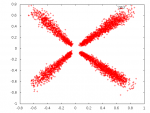I am starting a new thread here which I intend to be devoted to the discussion of the design and construction of and experimentation with hardware associated with the effective demodulation of complex digitally modulated RF signals; especially that beyond the simple FM discriminator taps heretofore well discussed and understood (though, due to the limitations in terms of money and resources of those of us involved in this at the hobby and personal experimental level, I certainly would not exclude discussions concerning getting more out of the old tried and true FM discriminator tap efforts at this stage if at all possible!). This can be looked at as a companion thread to the software discussion concerning the rather new and innovative DSD demodulation software.
Some discussion of this has already started on that thread as well as Unitrunker's ProVoice demodulation thread. I would like to request that the moderators move those posts concerning this hardware discussion off of both of those threads and move them here when convenient. I feel we inadvertently hijacked both of those threads and would like to set things right as well as give us "hardware fiends" a proper thread for discussion.
The primary intent, from my point of view, of this thread is to discuss effective hardware designs and implementation to deal with the more complex forms of digital modulation wherein much of the information is contained in the phase and/or amplitude of the signals rather than just the frequency deviations as in the comparatively simple C4FM mode. This would include discussion of LSM CQPSK and any other of the more complex digital modulation modes commonly used in RF transmission.
Also, as I stated above, any good results coming from this discussion can be used to better enable the software efforts as discussed in the DSD thread.
I hope this leads to interesting and effective discussions and look forward to what the future may bring as a result of these efforts, both from a software and hardware standpoint.
Once again, I apologize on my part, for the inadvertent hijacking of those other threads!
-Mike
Some discussion of this has already started on that thread as well as Unitrunker's ProVoice demodulation thread. I would like to request that the moderators move those posts concerning this hardware discussion off of both of those threads and move them here when convenient. I feel we inadvertently hijacked both of those threads and would like to set things right as well as give us "hardware fiends" a proper thread for discussion.
The primary intent, from my point of view, of this thread is to discuss effective hardware designs and implementation to deal with the more complex forms of digital modulation wherein much of the information is contained in the phase and/or amplitude of the signals rather than just the frequency deviations as in the comparatively simple C4FM mode. This would include discussion of LSM CQPSK and any other of the more complex digital modulation modes commonly used in RF transmission.
Also, as I stated above, any good results coming from this discussion can be used to better enable the software efforts as discussed in the DSD thread.
I hope this leads to interesting and effective discussions and look forward to what the future may bring as a result of these efforts, both from a software and hardware standpoint.
Once again, I apologize on my part, for the inadvertent hijacking of those other threads!
-Mike
Last edited:


